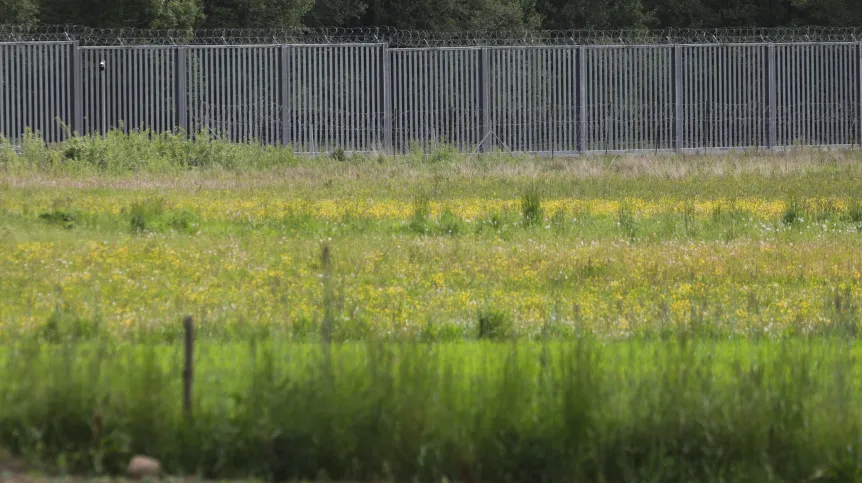
Foxes, raccoon dogs and martens search for food near military posts and penetrate the barrier on the Polish-Belarusian border, the barrier is impassable for larger mammals, report scientists who investigate the impact of the border fortification on the nature of the Białowieża Forest.
'Human activity in the Białowieża Forest is more intense along the state border compared to forest roads', say the authors of a study on the impact of the infrastructure securing the state border on plants and animals living on the Polish-Belarusian border, in the Białowieża Forest.
They made the assessment based on measurements conducted using camera traps and human tracks encountered along transects.
The project was carried out by Dr. Katarzyna Nowak and Professor Bogdan Jaroszewicz from the Białowieża Geobotanical Station at the University of Warsaw’s Faculty of Biology, as well as scientists from the Mammal Research Institute and the Institute of Nature Conservation at the Polish Academy of Sciences, the Forest Research Institute and international partners who conducted similar studies in other border regions (USA-Mexico, Slovenia-Croatia, Czechia-Germany).
Dr. Nowak presented the preliminary results of the research at the 7th European Congress of Conservation Biology (https://eccb2024.eu), as reported on the website of the Faculty of Biology of the University of Warsaw.
The study also confirmed that small predators (foxes, raccoon dogs and martens) are able to cross numerous barriers on the border. The researchers say that they are attracted to the border area due to the possibility of finding food near military posts. Larger mammals do not cross these barriers.
'The results of comparing the border with roads in the forest include the statement that the number of encountered animal tracks is related to the distance from the edge of infrastructure and its type. Wild animals avoid both the state border and the edges of forest roads, and they avoid the border more because human activity (indicators of encountered human tracks and indicators recorded by camera traps) is higher there than along roads. Based on the study of tracks in the snow, it was noted that only mesocarp and domestic predators penetrate secondary border barriers (forest netting and concertina)’.
Scientists have been monitoring the natural situation near the border barrier since September 2023. The presence of animals is monitored in nine areas along the Polish-Belarusian border and in three areas along roads, at three different distances: on the edge, 250 m and 500 m from the edge. As part of the research, scientists use camera traps and transects. They also use sound recorders to monitor the level of anthropogenic noise (mainly in the strict reserve of the Białowieża National Park, due to limited equipment resources).
The scientists are also checking whether there are invasive species of plants or mosses along the border. Last year, they recorded species such as impatiens, goldenrod and horseweed.
The authors of the study say that by using various methods (transects, camera traps, sound meters, snow tracking, temperature recorders) 'they will be able to understand at least the initial effects of border militarisation on the nature of the Białowieża Forest and formulate recommendations for further monitoring and mitigation of these effects'.
The work carried out by the Białowieża Geobotanical Station is financed by a NAWA intervention grant for the project entitled 'Understanding and mitigating the ecological footprint of border barriers'.
Representatives of two scientific institutions in Białowieża wrote about the possible natural effects of the migration crisis in the east in Science in November 2021. The then head of the Białowieża Geobotanical Station, Professor Bogdan Jaroszewicz, as well as Dr. Katarzyna Nowak from the station and Professor Michał Żmihorski from the Mammal Research Institute PAS appealed to take into account the needs of nature when trying to solve this crisis.
'There is no doubt that the first priority is the humanitarian crisis and human tragedy that must be resolved', said Professor Jaroszewicz. 'However, we must not forget that the actions related to this crisis and securing the border have an impact on the ecosystems adjacent to the border, including the unique forest ecosystem of the Białowieża Forest. This impact will be visible for years to come, even in the form of rubbish (food packaging, water bottles, etc.) left in the forest."
Scientists also pointed out that the wall would cut off the migration routes of large mammals in the Białowieża Forest. They recalled published studies showing that border fences were more effective at blocking animal migration than human migration. Such data comes mainly from the USA and Mexico, but also from the border between Israel and Palestine. 'Generally, the more sophisticated the security measures, the more sophisticated (and expensive) the methods of human smuggling', Professor Jaroszewicz said.
In ‘Science’, the scientists also mentioned another threat to the valuable ecosystem: the risk of species invasion. 'The militarisation of the border region, accompanied by the construction of infrastructure and increased traffic of people and vehicles, also exposes this unique forest to plant invasions. They occur as a consequence of the transport of seeds on building materials and on shoes and machine tires', they wrote.
Scientists will present more detailed results of the new study in 2025.
PAP - Science in Poland
zan/ agt/ kap/
tr. RL













